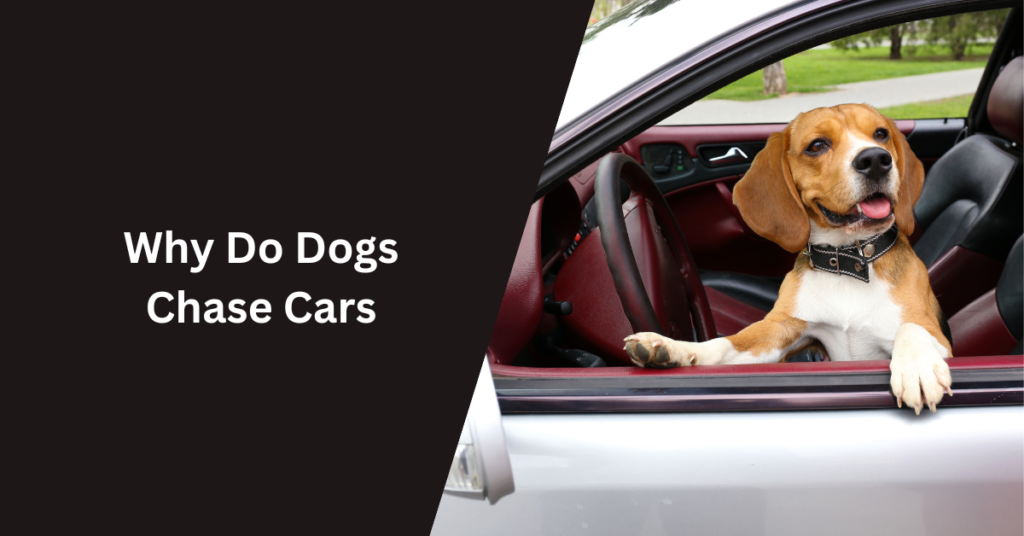Dogs chase cars because of instinct, excitement, and territorial behavior. Moving vehicles trigger their prey drive, making the chase feel natural. Some dogs also see cars as intruders and react to protect their space. Boredom, lack of exercise, or high-energy breeds can make this behavior stronger if not managed with training.
What Does Car-Chasing Mean?
Car-chasing is any behavior where a dog bolts toward, runs after, or lunges at moving vehicles, bikes, or scooters. It includes barking, fixating, sprinting, and nipping at tires.
It’s risky for people, pets, and drivers. Why Do Dogs Chase Cars matters because one mistake near a road can be fatal.
Why Do Dogs Chase Cars? Core Causes
Most car-chasing has multiple triggers. Research in canine behavior shows motion-sensitive prey drive, frustration from restraint, and learned reinforcement are common. A 2020 review in Frontiers in Veterinary Science highlighted how predatory motor patterns can be triggered by fast movement. Why Do Dogs Chase Cars often starts there.
Prey Drive And Motion Sensitivity
Dogs are wired to notice quick movement. Spinning wheels and sudden speed trigger chase. Herding and hunting breeds often react faster. Why Do Dogs Chase Cars? The motion flips a switch.
Herding Instinct
Border Collies, Aussies, and Kelpies may try to “control” moving objects. It feels like a job to them. Why Do Dogs Chase Cars becomes a misguided herding task.
Frustration And Barrier Aggression
Leashes and fences build pressure. The dog sees a car, can’t reach it, and explodes with barking or lunging. Studies on barrier frustration show higher arousal and reactivity near fences and windows.
Accidental Reinforcement
Each time a car drives away, the dog “thinks” the chase worked. That’s negative reinforcement. The behavior gets stronger. Why Do Dogs Chase Cars? Because it keeps paying off.
Under-Exercise And Low Enrichment
Bored dogs seek thrills. Without daily outlets—sniffing, training, puzzles—they chase. A 2023 survey of pet dogs linked enrichment to lower unwanted arousal.
Territorial Behavior
Some dogs guard yards, driveways, or mail routes. Moving vehicles trigger “intruder” alerts. Why Do Dogs Chase Cars becomes a loud warning system.
Medical Or Sensory Issues
Pain, poor vision, or cognitive changes can lower impulse control. A 2022 paper on canine cognitive dysfunction noted higher reactivity in some seniors. If behavior changes fast, call your vet.
The Real Risks You Should Know
Car-chasing leads to traffic accidents, severe injuries, and legal trouble. Insurance claims and citations are common in chase-related incidents, according to municipal reports and veterinary case studies. Why Do Dogs Chase Cars may sound silly, but the outcome can be tragic.
How To Stop It: A Step-By-Step Plan
I use a clear mix of management, training, and enrichment. This aligns with humane training guidelines endorsed by veterinary behavior groups since 2023.
Step 1: Lock Down Safety
Use secure fencing, window film, baby gates, and double leashing near roads. Walk on quiet routes first. If your dog rehearses the chase, it gets worse.
Step 2: Meet Needs Daily
Give 60–90 minutes of split sessions: brisk walks, sniffaris, tug, fetch with rules, and puzzle feeders. Enrichment reduces arousal. Why Do Dogs Chase Cars less when the brain and body are satisfied.
Step 3: Teach An Emergency “Let’s Go”
– At home, say “Let’s go,” turn away, pay 3–5 treats as you move.
– Practice 20 reps, then add mild distractions.
– Use it before your dog locks onto a car.
Step 4: Build A Rock-Solid “Look” Cue
– Say “Look.” When your dog meets your eyes, mark “Yes!” and treat.
– Gradually add distance exposure to parked cars, then slow cars far away.
– Keep success rate above 80%.
Step 5: Counter-Condition The Trigger
At a distance where your dog stays calm, every car predicts 1–3 tasty treats. Car appears = treats rain. Car gone = treats stop. This flips the emotional script.
Step 6: Add A Default Sit Or Sniff
Teach “Car means sit and sniff.” Cue sit, scatter 5 small treats to the ground as a car passes. Dogs can’t chase if they’re foraging at your feet.
Step 7: Progress Gradually
– Start with slow vehicles at 150–300 feet.
– Reduce distance in small steps over days.
– If barking starts, you’re too close. Back up and lower criteria.
Step 8: Log Sessions And Wins
Track distance, speed, and your dog’s arousal. Aim for short, successful reps. Two 5–8 minute sessions beat one long session.
Common Myths I Hear A Lot
– “He’ll grow out of it.” Many dogs grow into it, not out of it.
– “Just let him learn a lesson.” That lesson could be a hospital visit.
– “Shock collars fix it fast.” Research ties aversives to stress and fallout.
– “Only herding breeds chase.” Any dog can learn to chase.
These myths ignore why Why Do Dogs Chase Cars becomes self-rewarding.
Puppy Prevention Playbook
– Socialize puppies with calm, far-away traffic.
– Pay for calm looks at cars.
– Build recall, “Let’s go,” and “Look” early.
– Daily sniffing and puzzle time to lower arousal.
Stopping Why Do Dogs Chase Cars in puppies is much easier than fixing it later.
When To Call A Pro
If your dog fixates, can’t eat near cars, or has bitten tires, get help from a certified trainer or veterinary behaviorist. A 2021 analysis found complex chase behaviors improved faster with supervised counter-conditioning and structured management. Your vet can also rule out pain.
FAQ’s
How Do I Start If My Dog Already Lunges At Cars?
Begin far from traffic where your dog stays under threshold. Pay for eye contact and calm. Use the “Let’s go” turn-away before fixation. Add distance first, then speed, then closeness.
Which Breeds Are Most Likely To Chase?
Herding and high-prey breeds react faster, but any dog can learn to chase if it’s reinforced. Ask “Why Do Dogs Chase Cars” about your dog’s triggers, not just the breed.
Are Aversive Tools A Good Shortcut?
No. Studies since 2019 link aversives to stress, fear, and rebound behaviors. Positive methods show better welfare and long-term results.
How Long Does Training Take?
Many families see progress in 2–4 weeks with daily short sessions. Severe cases can take 2–3 months. Consistency and distance control matter most.
Can I Ever Run My Dog Near Roads Again?
Yes, but only after steady progress. Use a front-clip harness, keep a safe buffer, and practice “Look” and “Let’s go.” If arousal spikes, step back in the plan.
Conclusion
Why Do Dogs Chase Cars happens because motion sparks instinct, frustration builds, and the chase “works.” You can change that story. Start with rock-solid management, meet daily needs, and retrain emotions with distance, rewards, and smart cues.
Try the plan this week. Track your progress. If things stall, bring in a certified pro for faster, safer results.
Want more calm, happy walks? Subscribe for updates, ask a question in the comments, or share your progress with me.
I’ve loved dogs all my life and have cared for many different breeds over the years. Here, I share simple tips, stories, and helpful advice for all dog lovers. Whether you’re a new pet parent or a lifelong dog fan, you’ll find something useful and fun on my site.


